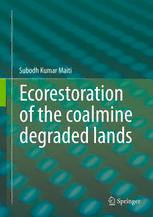Table Of ContentEcorestoration of the coalmine
degraded lands
Subodh Kumar Maiti
Ecorestoration of the
coalmine degraded
lands
SubodhKumarMaiti
IndianSchoolofMines
DepartmentofEnvironmentalScienceandEngineering
CentreforMiningEnvironment
Dhanbad,Jharkhand
India
ISBN:978-81-322-0850-1 ISBN:978-81-322-0851-8(eBook)
DOI:10.1007/978-81-322-0851-8
SpringerNewDelhiHeidelbergNewYorkDordrechtLondon
LibraryofCongressControlNumber:2012954478
#SpringerIndia2013
Thisworkissubjecttocopyright.AllrightsarereservedbythePublisher,whetherthewholeor
part of the material is concerned, specifically the rights of translation, reprinting, reuse of
illustrations,recitation,broadcasting,reproductiononmicrofilmsorinanyotherphysicalway,
andtransmissionorinformationstorageandretrieval,electronicadaptation,computersoftware,
orbysimilarordissimilarmethodologynowknownorhereafterdeveloped.Exemptedfromthis
legalreservationarebriefexcerptsinconnectionwithreviewsorscholarlyanalysisormaterial
suppliedspecificallyforthepurposeofbeingenteredandexecutedonacomputersystem,for
exclusiveusebythepurchaserofthework.Duplicationofthispublicationorpartsthereofis
permitted only under the provisions of the Copyright Law of the Publisher’s location, in its
currentversion,andpermissionforusemustalwaysbeobtainedfromSpringer.Permissionsfor
usemaybeobtainedthroughRightsLinkattheCopyrightClearanceCenter.Violationsareliable
toprosecutionundertherespectiveCopyrightLaw.
Theuseofgeneraldescriptivenames,registerednames,trademarks,servicemarks,etc.inthis
publicationdoesnotimply,evenintheabsenceofaspecificstatement,thatsuchnamesare
exempt from the relevant protective laws and regulations and therefore free for general use.
Whiletheadviceandinformationinthisbookarebelievedtobetrueandaccurateatthedateof
publication, neither the authors nor the editors nor the publisher can accept any legal
responsibilityforanyerrorsoromissionsthatmaybemade.Thepublishermakesnowarranty,
expressorimplied,withrespecttothematerialcontainedherein.
Printedonacid-freepaper
SpringerispartofSpringerScience+BusinessMedia(www.springer.com)
Foreword
Indian economy has grown at a CAGR of 7.6% in the first decade of the
twenty-firstcentury,andthecoalindustryhasplayedaveryimportantrolein
sustainingthiseconomicgrowth.Coal isthemostimportant mineralmined
inthecountryandaccountsfor52%ofitscommercialenergyconsumption.
Indiangovernmentisgivingamajorthrustfordevelopmentofthepower
sectoraselectricalenergyisakeyinputforeconomicgrowth.Theinstalled
capacity for generation of electricity has gone up from 101.6 GW in
2000–2001 to 200 GW in 2011–2012 (CAGR 6.3%). In the XII Five-Year
Plan, another 90 GW generation capacity is planned to be installed. As
approximately 70% of the power generated in the country is coming from
coal-firedpowerstations,suchmajorexpansionofthepowersectorrequires
commensurate expansion of the coal mining sector. Along with the power
sector, the steel and cement sectors in the country are also undergoing
expansionatarapidrateaddingtotheincreasingcoaldemandinthecountry.
Indian coal production was 322.7 Mt in 2000–2001 and reached a level of
534.5 Mt in 2011–2012 registering a compounded annual growth rate of
4.7%.TheXIIFive-YearPlannowunderformulationstagehasprojectedan
expansion of the coal mining sector at a higher rate of 8.2% for coal
production to reach 795 Mt in 2016–2017. The demand for coal is so high
thatevenwiththeprojectedrateofexpansionofindigenousproduction,the
countrywillneedtoimportapproximately200Mtofcoalin2016–2017.
MostofthecoaldepositsinIndiaoccurinforestedtractswithmanymine
leaseholdscontaininglargepatchesofforestland.Thesedays,almost90%of
coal produced in India comes from opencast mines. Large mechanised
opencast mines with high-stripping ratios exceeding 1 in 4 and in some
caseseven1in6or1in7andgoingtogreatdepthsinevitablycauselarge-
scale deforestation and loss of soil cover over large areas and creation of
hugeexternaloverburdendumps.
ThetotallandrequirementinIndiaformineoperation,wastedumpsand
mine infrastructures is projected to increase from the level of 1,470 km2
(includingaforestareaof730km2)in2006–2007to2,925km2(includinga
forest area of 730 km2 in 2025) as per ‘Vision Coal-2025’ document. The
technology of opencast mining inevitably leads to complete degradation of
land, destruction of forest ecosystem and fragmentation of wildlife habitat,
andmagnitudeofdevastationissomassivethatentirelandscapeoftheareais
changed. The only saving grace is that unlike other industries, mining is a
temporary user of land and with proper scientific restoration, a functioning
v
vi Foreword
ecosystem can be restored, and in some cases even a better landscape can
be created. Several organisations are concerned about the problem and are
actively involved in carrying out scientific restoration work in mined out
areas.Theuniversitiesandotherorganisationsteachingminingcoursehave
incorporated the subject of mine closure and ecorestoration in the mining
environment syllabus.One constraint facedby the students aswell as prac-
tising engineers of the subject is the lack of availability of books dealing
specifically with restoration of mine degraded land in India. Dr. Subodh
KumarMaitihasbeenworkingintheCentreofMiningEnvironment,Indian
SchoolofMines,Dhanbad,formorethantwodecadesandhasbeenteaching
andconductingresearchonthesubject.
Inthisbook,Dr.Maitihasdiscussedthescientificbasisofecorestoration,
the different ways one can achieve the goals, and explains how the ecores-
toration can be made self-sustainable. This book is presented in two parts:
PartIdealingwithdifferentaspectsofecorestorationandPartIIdealingwith
sampling, laboratory analysis and evaluation of overburden materials, soils
andplants.
Public opposition to mining is increasing in most parts of the world.
Generalpublichasbecomemoreawareoftheimportanceofpreserving the
environment and ecorestoration of mine degraded lands. The social licence
for mining, given by the Ministry of Environment in the form of environ-
mental clearance for a project, generally requires the mine management to
carry out systematic reclamation of degraded mined-out land. I hope this
book by Dr. Maiti will be useful for the environmental professionals in the
mining industry, students of mining engineering course, mine planners as
wellasthegeneralpublic.
FormerProfessorandHead S.P.Banerjee
CentreofMiningEnvironment
IndianSchoolofMines,Dhanbad
Preface
India is essentially a land-short economy. Its demand for usable land is
growing at an exponential rate. Mining of minerals is put into the category
of‘temporaryuseofland’.Centuriesofmininghaveresultedinmanymining
landbeyondanycommercial,recreationalorsocialuse.Itisnowimportant
torestoresuchlandforfruitfuluseandalsotoplanthefuturemininginaway
sothattheusedlandcanbereusedinthefuture.
Coal mining industry in India plays a very important role in country’s
economy—morethan70%ofthetotalpowergeneratedinthecountryisfrom
coal. India’s coal consumption ranks third in the world, and the country’s
demandforcoalcontinuestogrowmuchfasterthantheworldaverage.Coal
depositsaremainlyfoundundertheforestcoverandareconfinedtoeastern
andsouthcentralpartsofthecountry.Indiancoalsectorispoisedtogrowata
very fast rate in the near future due to steep increase in coal demand for
providingpowertoallby2012.Totalindigenouscoalproductionisexpected
to grow from the current level of around 540 Mt (2011–2012) to around
1,086Mtby2024and2,037Mtby2031–2032asperthedraftCoalVision
document,andmorethan90%willbeproducedbyopencastmining.
The quantum jump in coal production from opencast operation and con-
sequent overburden removal will put significant stress on the environment
duetototaldestructionofthevegetationandsoilcover,formationofwaste
dumps,depletionofwatertables,increaseindustpollutionanddeterioration
oflandscapeandaestheticsofthearea.Thetotallandrequirementformine
operation,wastedumpsandmineinfrastructuresisprojectedtoincreasefrom
the level of 1,470 km2 (including a forest area of 730 km2) in 2006–2007
to 2,925 km2 (including a forest area of 730 km2 in 2025) as per ‘Vision
Coal-2025’document.
In India, majority of the new and unmined mineral and coal deposits is
underforestcover;thus,completedegradationofland,destructionofforest
ecosystem and fragmentation of habitat are inevitable, and magnitude is so
massivethatentirelandscapeischanged.Fortunately,unlikeotherindustries,
mining is very temporary user of land, and proper scientific ecorestoration
can restore the functioning of ecosystem and may bring better landscape.
There is a growing concern to make the land useful yet again. Several
organisations are concerned about these aspects and are actively involved
tocarryoutrestorationwork,butnobookasguideisavailableuntildateto
vii
viii Preface
dealwithrestorationofdegradedland.Afterworkingmorethantwodecades
inCentreofMiningEnvironment,IndianSchoolofMines,Dhanbad,which
isknownastheMiningCapitalofIndia,Ifeelabookinthislineisoverdue.
Thepurposeofthisbookistodiscussthescientificbasisofecorestoration
andinwhatdifferentwaysonecanachievethegoalsandhowtoensurethat
the ecorestoration is self-sustainable. This book is presented in two parts:
Part I contains different aspects of ecorestoration, and Part II contains
laboratoryanalysisandevaluationofoverburdenmaterials,soilsandplants.
Thisbookispresentedasfollows:
Part I
Chapter1providesanintroductiontotheimportanceofcoalmininginIndia
and relevant environmental issue, principles and components of ecores-
toration, issues related to restoration, legal and statutory framework of
ecorestoration.
Chapter2givesthebasicconceptsofecologyandfunctioningofecosystem
inminedegradedareas.
Chapter 3 discusses the importance of physical reclamation for ecorestora-
tionprocess,estimationofsedimentlossfrombareareas,designofdiversion
ditchesandsedimentpond.
Chapter4reviewstheimportantpropertiesofminesoilthatisgoingtoaffect
theplantestablishmentandgrowthinminedegradedlands.
Chapter 5 stresses the importance of topsoil management, which includes
removal,storageandredistributionoftopsoil.
Chapter6discussesthemethodsofvegetationcoverdevelopment,selection
ofplantspeciesandcasestudiesrelatedtotheexistingtreecoversindifferent
dumps.
Chapter7introducestheimportanceofseedingforecorestoration,itscollec-
tion,preservationandbreakingofdormancy.
Chapter8providesthedetailsofnurseryraisingofforesttreespeciesforthe
ecorestorationpurposes.
Chapter9introducesthetechniquesoftheestablishmentofgrassandlegume
cover.
Chapter 10 introduces importance of mulching, geotextile and organic
amendments.
Chapter11discussestheimportanceofbio-fertiliser technologyforecores-
toration.
Chapter12introducestheimportanceofbiodiversity,causesofbiodiversity
erosionanditsmethodsofconservation.
Chapter 13 highlights the importance of monitoring and aftercare of ecor-
estoredsitesforthedevelopmentofself-sustainingvegetationcover.
Chapter14discussesthecriteriafortheevaluationofecorestorationsuccess
andindicators.
Chapter15providestheimportantforestandwildlifeconservationacts.
Preface ix
Chapter16discussestheecologicalimpactassessmentprocedureforsurface
miningprojects.
Chapter 17 highlights the importance of mine closure, objectives, issues,
planning, activity, cost, mine closure guidelines in India and preparation of
closureplanreport.
Part II
Chapter18introducesthesamplingandprocessingofsoilandminespoilsfor
laboratoryanalysis,onsitetestanddescriptionofparameters.
Chapter 19 provides detail laboratory analysis procedure of physical para-
meters like texture, bulk density, moisture content, infiltration test, rooting
depthetc.andtheinterpretationoftestresults.
Chapter20providesdetailanalysisofchemicalandnutritionalparameters.
Chapter21containslaboratoryprocedureofanalysisofsoilmicrobiological
parameters.
Chapter22 provides detail of vegetation sampling procedure, plant nutrient
analysis, pot and field trial experiments and analysis of plant growth para-
meters.
ISM,Dhanbad SubodhKumarMaiti
[email protected]

